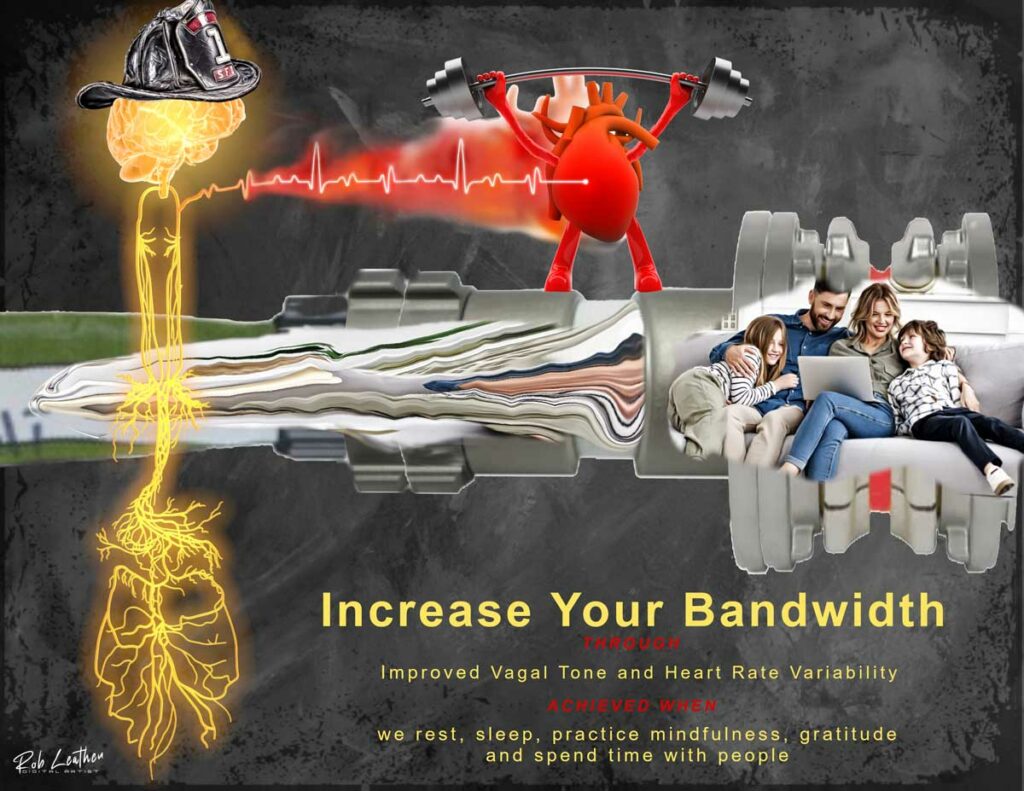Does Polyvagal Theory Hold the Key to Mitigating Our Exposure to Trauma?

As I’ve continued to learn more about mental health, suicide, and trauma, I realized the importance of increasing our individual resiliency as a layer of protection against stress and trauma. Initially, it appeared that the goal was to find the coping skills that work for you, as an individual, and ensure you are taking time to practice those skills. These proactive practices seemed easy enough, but with the speed of life, I fell into the same pattern of not having enough time to practice them—never mind the guilt that accompanied taking time to rest, sleep, play, journal, practice gratitude, and breathwork. I knew I was not alone, and that most of the professionals I worked with also felt similar. While self-care is important, there was just not enough time in the day to implement it, especially when there are just too many other obligations.
- Upstream Practices That Predict Firefighter Resilience
- Addressing Internal Conflict to Understand Suicide
- Dispelling Some Common Myths About Suicide
- Can Peer Support Prevent Firefighter Suicide?
Then I stumbled upon Ryan Munsey’s book, Master Your Mind, and had a major awakening as I read his chapter on “Polyvagal Theory (PVT) and Heart Rate Variability (HRV).” These are two very complex-sounding descriptors of what I believe is the simple secret to increasing our emotional resilience or the ability to respond to stressors. Basically, by improving HRV (also known as vagal tone) through awareness and activation of the vagus nerve, we can develop the capacity to maintain health, growth, and restoration. This leads to increased ability to withstand unpredictable stressors or exposure to trauma without becoming injured or “damaged.”
HRV measures the balance between the sympathetic (SNS) and parasympathetic (PNS) system. When we inhale, we stimulate the SNS by increasing the heart rate, and when we exhale, we stimulate the PNS, which decreases our heart rate. HRV is defined as the variation in time between heartbeats, and a higher HRV is associated with improved psychological well-being and quality of life. While increased HRV helps us perform optimally under stress, HRV only can increase during rest or any activity that decreases our heart rate. Basically, the SNS and PNS are in constant competition with each other, and the more balanced the competition, the higher your HRV is, and the better both systems can perform. I think of their functioning kind of like a tug of war, where the goal is balance and you reap the benefits of high performance.
The polyvagal theory is named for the function of the vagus nerve, which influences both our body and our brain and is responsible for our well-being and performance. The vagus nerve carries parasympathetic (rest and digest) information from the brain to the heart, lungs, liver, stomach, and intestines. However, depending on how it is influenced, it can either activate the prefrontal cortex through parasympathetic action or it can activate the limbic system through sympathetic action. Emotional resilience requires us to spend significantly more time in the parasympathetic nervous system as opposed to an activated sympathetic system. To be emotionally well, we must proactively recover by allowing our nervous system to relax.

Literature on the PVT helps to explain the evolution of our autonomic nervous system from its survival origins to today’s constant overstimulation and dysfunction caused by daily stressors and constant low-grade activation. In layman’s terms, early humans maximized the benefits of the autonomic nervous system for survival against attack. When necessary for survival, a cascade of chemicals flooded the body to enable us the ability to focus our energy on staying alive.
Modern society is a recent phenomenon. For hundreds of thousands of years, we relied on our nervous system to keep us safe, while also relying on cohesion that occurred when with our trusted tribe. Fascinatingly, belonging cues were the strongest signals that told our unconscious brains that we were safe, and did not need to worry about outside attack. Belonging clues signaled the ANS to shift into the PSN through recognition safety. These cues signaled that one is valued and the relationship is continuous.
However, today, humans experience chronic low-level activation of the autonomic nervous system while simultaneously failing to allow for its requisite recovery. Examples of low-level activation of our primitive response system include constant phone notifications, unhealthy relationships, and psychologically unsafe work environments, just to name a few. When existing in tandem with sleep deprivation, the destruction to our internal systems is exponentially increased. The PVT posits that purposeful recovery, resting, and even playing are necessary ingredients to emotional resilience, which is defined as our ability to respond appropriately to activation of the sympathetic nervous system.
The vagus nerve works in a bidirectional fashion. Under normal circumstances, it governs the subconscious control of the previously mentioned regions. Because we are primitive beings wired for survival, it can become activated and initiate our sympathetic fight-or-flight response. In our modern, dopamine-seeking, instant gratification, chronic inflammatory state, we can become stuck in an elevated state of fight or flight without the appropriate recovery found in the rest and digest state. The chronic inflammation that results from this elevated state of fight or flight leads to a wide range of negative health outcomes.
This dysfunction is just one reason that people who are exposed to trauma respond differently from one another and is why some people suffer from post-traumatic stress disorder (PTSD) while others can process trauma. In his research, Dr. Bessel Van Der Kolk discovered patients with PTSD had unusually low HRV compared to patients without the diagnosis (Van Der Kolk, The Body Keeps the Score). He is just one of many experts who have discovered this relationship and who advocate for practices that increase HRV.
The more your body remains in fight-or-flight mode, the more dysfunction our internal systems suffer due to improper activation of the limbic system and reduced HRV. This creates a perfect host environment for depression, anxiety, outbursts of anger, and post-traumatic stress symptoms. Chronic fight or flight leads to chronic inflammation, which can lead to a host of other poor outcomes, including increased susceptibility to cancer, depression, metabolic disorders, etc.
Fortunately, with practice, we can increase our bandwidth by training ourselves to become more emotionally resilient, thereby increasing our capacity to respond positively to uncertainty, threat, and daily stressors. Increased emotional resilience decreases our incidence of negative emotions, feelings, and thoughts. It is now well known among athletes that increasing HRV will improve recovery and increase performance. However, an unintentional finding was that each recovery activity that increased HRV also promoted emotional resiliency by shutting down defense responses and moving us from sympathetic to parasympathetic states. This process basically moves us out of the limbic emotional response default to a prefrontal-subcortical adaptive response.
Yoga is one practice that has a significant positive impact on HRV. In conducting studies on Marines and rape survivors, researchers found that yoga had significantly improved their arousal difficulties associated with PTSD, and dramatically improved their ability to overcome heighten emotional states. When the research institute compared yoga to dialectical behavior therapy (DBT), they discovered significantly more effectiveness on the individual who practiced yoga as opposed to receiving the therapy. Dr. Van Der Kolk explained that they kept the approach simple in their practices by placing the greatest focus on breathwork and utilizing a limited number of poses without much emphasis on getting them right. While they did not teach meditation, they did foster mindfulness by encouraging their students to observe what was happening with their bodies.
While our brains are designed to be adaptive and malleable, their normal operation functions by learning and repeating preprogrammed routes through creating efficient default responses. In this sense, once they learn a pattern, they subconsciously repeat that pattern when they recognize a familiar cue. Practicing those activities that stimulate the parasympathetic nervous system creates a path for the brain to fall into, thereby preventing the emotional responses associated with limbic system overactivation. Increased HRV is associated with slowing the aging process, preventing cancer, reducing incidences of PTSD, and improved sleep.
Basically, to increase HRV, thereby increasing our health, ability to recover and to become more emotionally resilient, we must purposely spend more time in the parasympathetic state. We must actively work to train our brains to recognize the PNS system as a preprogrammed state. This is accomplished through sleeping, napping, breath work, cold exposure, yoga, mindfulness, meditation, gratitude, journaling, or anything that can disconnect you from the fast-paced life that is so common for many in today’s world.
While this sounds easy, implementation is the challenge. However, if we truly want to become more resilient and create more resilient organizations, we must learn to train our prefrontal cortex to become the default pathway over the limbic system’s primitive response. This takes awareness, practice, and deliberate effort to rewire your brain and create new pathways through practiced habits. Though it sounds counterproductive (and lazy), these practices must include proactive use of rest and recovery.
Here is a short list of practices that can improve your heart rate variability:
- Time with loved ones
- Good consistent sleep (I know, easier said than done)
- Hydration
- Morning exposure to sunlight
- Exercise
- Navy SEAL Box Breathing
- Journaling
- Breath work with a focus on longer exhalations (inhale for 4, hold for 4, exhale for 5, hold for 4)
- Cold Exposure (Showers/Ice Baths)
- Play (any activity that reminds you of your youth or that causes you to lose track of time while engaged)
- Gardening
- Daily expressions of gratitude
- Psychologically safe work environments
- Leisure
- Therapy animals, pets, emotional support animals, etc.
Dena Ali is a battalion chief in the Raleigh (NC) Fire Department with 15 years of service. She has a master’s in public administration from the University of North Carolina at Pembroke

